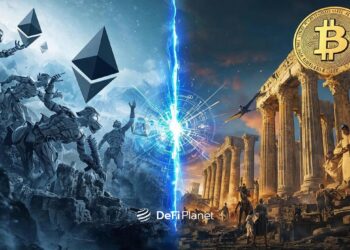Last updated on June 21st, 2023 at 04:58 pm
Technology, essentially, revolutionized the past century, from the internet to many specific fields like finance where blockchain technology originally comes into. Blockchain technology came into existence about 12 years ago and is currently disrupting major sectors of the global economy, especially finance.
With the development of virtual assets like Bitcoin and Ethereum, transactions are now more secure, fast, and cheaper to an extent. In order not to be left behind, traditional financial institutions, supply chain, energy, and healthcare are part of the sectors adopting blockchain technology to enhance seamless operations. Just as blockchain is still in its early stages of growth and adoption, another technology called Hashgraph seems to be up against it.
Hashgraph is an advanced information-sharing technology that allows for secure transactions — such as digital money transfers — without a centralized computer system. The entire system is hosted by the network of computers that use it.
A brief overview of Blockchain
The blockchain is defined as a decentralized, distributed ledger technology that stores transactional records in blocks, and is accessed by the participants connected to the network.
Every time a transaction is added, it becomes another block and forms a chain. It creates an unchangeable record of transactions that can never be erased. Blockchain uses cryptography to provide security to the blocks of records, making the owner have a track of the record through which he can trace it.
Blockchain forms a peer-to-peer network where participants can communicate among themselves over the network. In blockchain technology, once records are added, they are timestamped —this means records cannot be rewritten or discarded. This is a major reason why many organizations are adopting this technology.
Blockchain technology came into light in 2009 to verify Bitcoin transactions — Bitcoin blockchain. The second most popular cryptocurrency, Ethereum, makes use of its own technology called the Ethereum blockchain.
Overview of Hashgraph
The Hashgraph is an advanced information-sharing technology that allows for secure transactions, such as digital money transfers, without a centralized computer system. This technology was invented by Dr Leemon Baird who pioneered Swirl Inc together with his close associate, Mance Harmon in 2016.
These cofounders wanted a situation where developers could build distributed applications, such that the programs will be hosted on different computer systems that will make use of it and not a central network.
With Hashgraph being the solution to their quest, it was developed with a distributed consensus algorithm so that computers on the Hashgraph’s network will validate a particular transaction only after agreeing on it.
With Hashgraph operating in a distributed manner, developers can build trusted apps, transactions can be verified accurately and swiftly without the need for a central network.
How the Hashgragh works
The working principle of the Hashgraph is different from the blockchain. Two techniques this technology uses to verify transactions are Gossip about Gossip and Virtual voting.
Gossip about Gossip
In the process of Gossip about Gossip, the nodes using the Hashgraph will communicate to each other about an event, such as a transaction occurring between nodes A and B. Furthermore, the nodes will communicate some bits of information regarding the event such as transaction time, nodes involved, and many more.
Technically, the Gossip to Gossip technique works in the following ways:
- Every node will talk about the hashes attached to the last two nodes, say A and B.
- All nodes in the Hashgraph expand the signed information on new transactions attached to A and B to a randomly chosen adjacent node.
- The randomly chosen adjacent node will combine the newly created events with the piece of information received from the last nodes, thus creating a new event.
- The cycle is repeated until all the nodes in Hashgraph have the same information.
Virtual voting
Virtual voting is a means of verifying which transactions in the Hashgraph is valid. In this case, if new information is provided, all nodes will know the initiator. The pieces of information will then be fed to the voting algorithm to know which transaction has reached a consensus. If a transaction is witnessed by 2/3 of the nodes in the network, it is valid.
Compared to other decentralized ledger technologies, Hashgraph is believed to be the gold standard of security because it is Asynchronous Byzantine Fault Tolerant (aBFT) — meaning transaction verification is reached via consensus, backed by mathematical operations.
Features of the Hashgraph
There are basically three features that are unique to the Hashgraph. These include:
- Transparency
The uniform time-stamping technique and the distributive nature of this technology make it transparent. This feature makes it fairer than other DLTs.
- Security
Hashgraphs have an asynchronous Byzantine Fault Tolerant System, making it impossible for a node to prevent the community from reaching a consensus or even making a U-turn after consensus has been reached. This forms the basis of security for this technology.
- Faster transactions
With the Hashgraph technology, more than hundreds of thousands of transactions can be handled and over a million signatures verified per second, respectively.
The Hedera Hashgraph
The Hedera Hashgraph is a distributed ledger technology that provides a fast, fair and secure infrastructure to validate transactions via consensus and to run Decentralized applications (dApps). It is the public version of the Hashgraph.
Its lightning-fast feature and mathematically backed Asynchronous Byzantine Fault Tolerance makes it useful for public and private DLT, including cryptocurrency and dApps.
The Hedera Consensus Service which is available on the Hedera Mainnet, allows developers to create verifiable timestamps as well as events for applications. Just like the blockchain, this consensus eliminates the need for a central authority. This use of the Hedera cuts across various sectors including finance, supply chain, and more. It can also be applied in blockchain frameworks like Hyperledger Fabric and R3’s Corda.
Applications of Hedera Hashgraph
The Hedera Hashgragh has several applications including payments, tokenization of assets, fraud prevention, and data compliance
- Payments
With the Hedera token service, organizations can leverage the public distributed ledgers to facilitate payment in a secure manner. It guarantees efficient settlements and enables liquidity for new and existing markets. Hedera also makes stablecoins and other cryptocurrencies ideal for settlements in finance and e-commerce, at lower fees and faster speed.
- Tokenized assets
The Hedera Token Service enhances the easy configuration, minting, and managing of both fungible and non-fungible tokens without smart contract deployment. Assets that could be tokenized include regulated securities, lands, or decentralized governance tokens.
- Fraud prevention
Besides reducing cost, increasing speed, and building trust, the Hedera Hashgraph platform prevents fraud. This is done by ensuring all participants are trusted and related systems have a real-time view of transactions used to detect fraudulent activities.
- Data Compliance
The Hashgraph can help organizations build trust around clients’ data by allowing them to offer an auditable log of actions taken. This is to assure customers that their data isn’t going to the wrong hands.
Blockchain vs Hashgraph
Blockchain and Hashgraph technology have some disparate properties. These include:
- Transaction speed: In blockchain technology, transaction speed depends on implementing protocols or solutions such as hyperledger, cryptocurrency, or even the blockchain platform. About 100 to 10,000 transactions are processed per second. The Hashgraph, on the other hand, is faster than the blockchain, processing up to 500,000 transactions per second. This is because the Gossip for Gossip technique requires less information to process more events taking place.
- Transaction efficiency: Because of the block approach in blockchain, a miner cannot work on two blocks simultaneously. As a result, the other block is discarded, leading to wasted efforts. In the case of the Hashgraph, since blocks are not used, time and effort aren’t. Hence, it is considered 100% efficient.
- Consensus mechanisms: Depending on the type of cryptocurrency, different consensus algorithms such as proof-of-work, proof-of-stake, proof-of-elapsed time, etc are used in blockchain. Hasgraph uses either the Gossip for Gossip or Virtual voting to gain network consensus. It does not require high computational power and electrical supply or any other algorithms as it can provide low-cost and high performance without failure.
- Adoption: In the case of development and adoption, blockchain technology is more pronounced than the Hashgraph. Blockchain is slightly over a decade and is still being developed and explored. The hash, on the other hand, is patented and Hedera (the public variant) has about 415,456 accounts on its mainnet.
Where Hashgraphs has the upper hand…
The Hashgraph technology matches up to the blockchain in two major areas considered a challenge. This is the area of the speed and fairness of transactions.
While Bitcoin is suggested to handle about 7 transactions per second, and Ethereum about 15 per second; the Hashgraph is said to manage about 500,000 transactions per second.
In the case of transaction fairness, there are times users will have to wait for more than 29 minutes for transactions to be processed. This is because miners manually upload the transactions to blocks. And since miners can work on only one block at a time, they have to choose that which favours them — the one with higher transaction fees. As a result, users whose transaction fees are lower will have to wait.
The Hashgraph, however, does not use the block technique.
In Conclusion…
- Both blockchain and Hashgraph technology share similar properties, with the latter slightly posing a threat to the former. However, because the Hashgraph is a permissioned and patented network, the number and identity of the nodes participating in the network must be known.
- The idea of Hashgraphs displacing the blockchain which is open-source, decentralized, and not permissioned is kind of strange. Besides the Hedera Hashgraph, there is no other public version of the Hashgraph.
If you would like to read more articles like this, follow DeFi Planet on Twitter and LinkedIn.





















